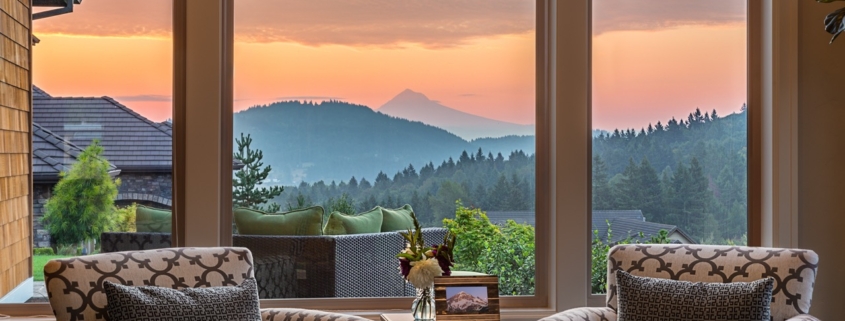What Are Picture Windows And Are They Popular?
Picture windows are a type of window that are designed to provide unobstructed views of the outside surroundings. Unlike other types of windows that can be opened or have additional features like screens, these windows are stationary and cannot be opened. They are popular in modern architecture due to their sleek and minimalist design. This article will explore the definition, key features, history, popularity, pros and cons, and the installation and maintenance of picture windows.
What Are Picture Windows?
The definition of picture windows is fairly straightforward – they are large, fixed windows primarily intended to provide panoramic views and let in abundant natural light. Their design often features a single glass pane, maximizing the viewable area and making them ideal for showcasing breathtaking landscapes or city skylines.
Picture windows are not just ordinary windows; they are architectural elements that can transform the entire ambiance of a room. Their expansive size and unobstructed views create a seamless connection between the indoors and the outdoors, allowing you to feel immersed in nature even when you’re inside.
Imagine waking up in the morning and being greeted by a stunning sunrise or enjoying coffee while gazing at a picturesque garden. Picture windows bring the beauty of the outside world into your living space, creating a sense of tranquility and serenity.
Key Features
One of the key features of picture windows is their expansive size, typically spanning from floor to ceiling and wall to wall. This creates an illusion of open space and allows an unobstructed view of the outdoors. It’s like having a giant canvas that frames the world outside, turning it into a living work of art.
But picture windows offer more than just breathtaking views. They also provide exceptional energy efficiency and insulation. With no operable parts, these windows eliminate the risk of air leakage and minimize temperature transfer. This means you can enjoy nature’s beauty without compromising on comfort or energy consumption.
History
Origin and Evolution
The idea of picture windows dates back to ancient Roman architecture, where theaters used large open frames to provide panoramic views of the surroundings. However, during the modernist movement in the 20th century, picture windows gained prominence in residential and commercial buildings.
Architects like Ludwig Mies van der Rohe and Frank Lloyd Wright championed expansive windows to blur the boundary between indoor and outdoor spaces. This architectural style, the International Style, embraced simplicity, clean lines, and a connection with nature.
Architectural Significance
Picture windows have since become a functional element of architectural design and a symbolic one. Their use in modern architecture signifies a shift towards openness, transparency, and a connection to the natural environment. They allow inhabitants to enjoy the beauty of their surroundings, fostering a sense of tranquility and promoting well-being.
Popularity
Reasons for Their Popularity
Picture windows have gained popularity for several reasons. Firstly, their sleek and minimalist design adds a touch of elegance and modernity to any space. They can transform a room by flooding it with natural light, creating an open and airy atmosphere. They also connect visually to the outside world, making even small spaces feel larger and more expansive. This is particularly advantageous in urban areas where views might be limited. Lastly, the energy efficiency of picture windows is highly valued by homeowners. The lack of operable parts means no gaps or cracks can lead to heat loss or air infiltration. As a result, picture windows contribute to reducing energy consumption and lowering utility bills.
Current Trends in Picture Windows
There has been an increasing trend towards sustainable and eco-friendly architecture in recent years. This has led to the development of energy-efficient picture windows with advanced glazing technologies and insulated frames. Additionally, there is a growing demand for customizable and larger-sized picture windows to maximize views and create unique architectural statements.
Furthermore, integrating smart home technology has influenced the popularity of picture windows. Homeowners can now control the tint, opacity, and even the ability to switch from clear to frosted glass with just a button, enhancing privacy and convenience.
Pros and Cons of Picture Windows
Advantages
Picture windows offer numerous advantages. As previously mentioned, their large size and unobstructed view provide a sense of openness and connection to the outdoors. They also allow ample natural light to enter the space, reducing the need for artificial lighting during the day and creating a more inviting ambiance.
Their stationary nature eliminates the risk of accidental openings or the need for additional safety measures, making them a secure option for families with children or homes in areas prone to extreme weather conditions. Additionally, with fewer moving parts, picture windows are relatively low maintenance compared to operable windows.
Disadvantages
Despite their many benefits, picture windows do have some drawbacks. One of the main disadvantages is the lack of ventilation. Since they cannot be opened, picture windows do not allow for direct airflow, which can be a concern in areas with high humidity or limited air circulation.
Another consideration is privacy. Window treatments or tinted glass can be installed to address this issue, but they may affect the visual appeal or obstruct the view.
Maintenance
Installation Process
Installation requires careful planning and professional expertise. The process involves removing the existing window or creating a new opening in the wall to accommodate the large size of the picture window. Ensuring proper insulation and weatherproofing is crucial to prevent air and water leaks. A skilled contractor will ensure a precise fit, secure installation, and appropriate sealants or flashing to protect against moisture infiltration.
Maintenance Tips
Maintaining picture windows is relatively straightforward. Regular cleaning of the interior and exterior surfaces will keep them looking their best and prevent the accumulation of dirt or debris that may obstruct the view. Inspecting the window frame for any wear or damage, such as rot or cracks, is important. Addressing these issues promptly can prevent further damage and maintain the window’s structural integrity.
In closing
Picture windows are popular in modern architecture because they provide unobstructed views, abundant natural light, and sleek design. They have a rich history rooted in architectural significance and have evolved to incorporate energy-efficient and customizable features.
Window Depot USA of Tyler, TX, combines premium grade replacement window products with factory-direct pricing, a Transferable Lifetime Limited Warranty, and professional, courteous installation to offer the very best value in the industry today! Call us at (903) 752-0449 for a free, no-obligation quote, and find out firsthand what sets Window Depot of Tyler, TX, apart from the rest of the crowd. We’d be honored by the opportunity to earn your business!
Our service area includes the following towns: Tyler, Whitehouse, Bullard, Lindale, Chandler, Canton, Mineola, Longview, Kilgore, Henderson, Gilmer, Gladewater, Marshall, Hallsville, and Palestine.









